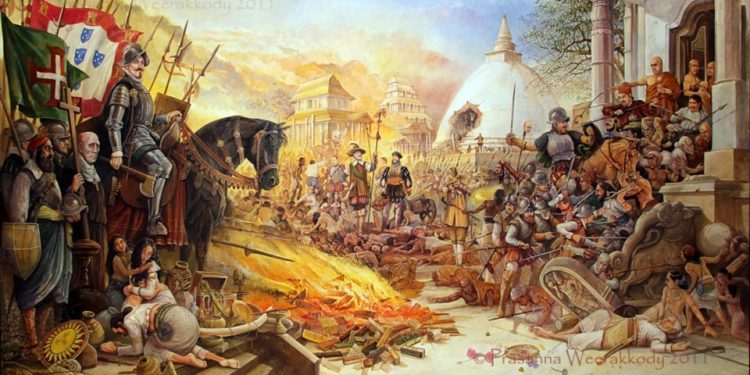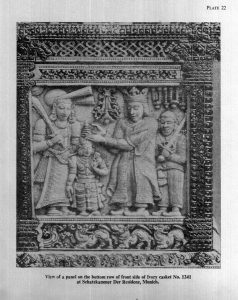How Lankan Buddhists won the battle against proselytization
Posted on November 23rd, 2020
By P.K.Balachandran/Ceylon Today
By the adoption of a variety of tactics, tailored to suit the power-equation at any given point of time, Lankan Buddhists kept blunting the attack and managed to preserve Buddhism as the dominant religion of the island.

Sri Lankan Buddhists came under a sustained and frontal assault by Christian missionaries during Portuguese and Dutch rule for nearly three centuries (1505 to 1796). Given the adverse balance of power, many Buddhists compelled or enticed to convert to Roman Catholicism under the Portuguese and to Calvinism under the Dutch. But by the adoption of a variety of tactics, tailored to suit the power-equation at any given point of time, Lankan Buddhists kept blunting the attack and managed to preserve Buddhism as the dominant religion of the island.
Sir James Emerson Tennent, Colonial Secretary from 1841 to 1850, traces the ultimate success of the Sinhala Buddhists to one of their innate qualities. In his book Christianity in Ceylon (John Murray, London, 1850), Tennent says: In the hands of the Christian missionary they (the Buddhists) are by no means the plastic substance which such a description would suggest – capable of being molded into any form or retaining permanently any casual impression – but rather an yielding fluid which adopts its shape to that of the vessel into which it may happen to be poured, without any change in its quality or any modification of its character.”
The nature of the assault on Sinhala-Buddhism and the ingenious ways in which the Buddhists tackled and overcame the threat are graphically described by Prof.P.V.J.Jayasekera in his book: Confrontations with Colonialism Vol:1 1796-1920 (Vijitha Yapa, 2017). Jayasekera uses the term Christian colonialism” for Portuguese and Dutch rule as both Christianity and colonialism as a politico-economic system went hand in hand. The agenda of the colonialists was to exercise political, economic and spiritual control over their subjects simultaneously. Indeed, the spiritual and the temporal reinforced each other.
The ideology of Christian colonialism” was rooted in the assertion of Pope Innocent IV in the 13 th.Century, that, as the Vicar of Christ, the Pope had the power not only over Christians but also over non-believers. Through a series of Papal Bulls and Inter Caeteras from 1455, the Portuguese and the Spanish were given the power to exercise temporal and spiritual control over believers and heathens the world over. They were authorized to vanquish, enslave, humiliate or subdue the non-believer in pursuance of the divine mission.”
In Sri Lanka, the Portuguese systematically destroyed Buddhist, Hindu and Islamic places of worship. Harsh laws were enacted to prevent the practice of indigenous religions. At that time, Lankan Buddhists believed that salvation could be reached through multiple paths and therefore allowed the Portuguese to engage in conversion. King Buvanekabau of Kotte (1458-1550) even invited missionaries, though he himself refused to convert.
But his grandson and successor, Dharmapala (aka Don Juan), converted in 1557. Put off by that, the Buddhists revolted. Thirty Bhikkus were martyred. There were at least ten popular revolts in 44 years. One of which was led by Edirille Rala (1594-1596) which the Portuguese described as the revolt of the Sinhalese nation”. Portuguese chronicler Queroz noted that a saintly monk Budavance” was behind the uprising in Sitavaka. Missionaries and churches were attacked. In 1630-1631, destruction of Portuguese properties was extensive. To put it down, the Portuguese stepped up destruction of places Buddhist and Hindu worship.
Interestingly, many of the rebel leaders like Edirille Rala, Kangara Arachchi and Nikapitiya Bandara were themselves converts! Many who converted for one reason of the other eventually revolted or relapsed to their old faith. This made the Portuguese (and later the Dutch) despair that conversion of a Sinhalese meant nothing really. Even 50 years after the establishment of Portuguese rule on the West coast, they were busy destroying Buddhist temples showing that missionary activity had not borne fruit. Disappointed with adult conversion, the Portuguese concentrated on children in the schools they set up.

Dutch Used Laws
The Dutch, who ruled Sri Lanka from 1658 to 1796 immediately after the Portuguese, were less violent but more legalistic in their proselytization. The Dutch used laws backed by a system of harsh punishments.. Baptism was needed to bequeath property. Marriages had to be registered in church. Many Buddhists had to convert on the death bed to bequeath their property to their heirs. A non-convert’s evidence was not admissible in court.
Schools were established mainly for the purpose of conversion and school masters were made in-charge of adherence to Christian practice. The Governors of the Dutch provinces (Disawes) accompanied by Dutch pastors inspected schools four times a year with armed escorts. Those who neglected their duties were severely punished. Heavy fines and forced labor in chains for three months were the order of the day. On seeing that people were ignoring the Placcaats or orders, the Dutch in 1732 issued an order asking all village headman to eliminate Buddhist temples in their areas. To enforce it, the Dutch enhanced punishment to 2000 Rix dollars or chained labor for 25 years.
But despite the harshness of the punishments, defiance by the Buddhists continued both passively and violently. In 1646, Kottapitiya Appuhamy of Weligama Korale, rebelled. Monks and Silvatas (lay preachers) openly mocked Dutch pastors. The put up anti-Christian arguments written on Ola leaves on tree trunk so that people could read.
Monks and lay preachers from Galle and Matara were particularly active, which made the famous Goan Jesuit missionary Fr.Jacome Gonsalves say that the Buddhists of Galle and Matara were particularly attached to Buddhism. The southern rebels had the full support of the Kandyan monks also. A desperate Dutch Galle district Church Council wrote to Amsterdam in 1736 saying: The native has an aversion to Christianity and is attached to Heathenism.”
The Buddhists fought hard for the recovery of the Kelaniya Raja Maha Viharaya, which the Buddha had visited and which the Dutch occupied. The Dutch had used the temple’s stones to build the Colombo Fort. In 1647, the Kandyan King Rajasinghe II (1629-1687) asked the Dutch to vacate the temple but he was ignored. Subsequently, King Wimaladharmasirya II (1687-1707) asked for permission to Buddhists to at least worship there. But the Dutch would not allow idolatry. The Dutch relented only 140 years later in 1780, when they decided that persecution would not work with the Sinhalese Buddhists.
(The painting at the top shows the Portuguese destroying a Buddhist temple in Sri Lanka: Picture credit goes to Prasanna Weerkkody)
November 25th, 2020 at 6:29 pm
While congratulating Mr. Balachandran for this article, in at least one thing he ERRS! He states that the Portuguese and the Dutch “ruled Ceylon”.
That implies that they ruled either the ENTIRETY of Sri Lanka, or even the MAJORITY of the land of Sri Lanka and the sovereignty of its indigenous people had ended. That was never soi during the Portuguese and Dutch colonial periods.
Neither the Portuguese nor the Dutch ever RULED Sri Lanka in that sense; only the Britsh achieved that much later in 1815.
Furthermore, of the Portuguese, the Dutch and the British, only the Portuguese made any significant PROGRESS in converting the Sinhala Buddhist to their alien Christian faith and that was due to certain Sinhala leaders, including a King. who collaborated with them.
Indeed, during Don Juan Dharmapala’s time, with his enthusiastic complicity, Buddhism was in Great Jeopardy threatened with eradication from Sri Lanka.
As an aside, I venture to say that a similar period of potential eradication of Buddhism and Sri Lankan Sovereignty under Don Juan Wickramasinghe ended recently with the defeat of the Yamapalanaya and the election of GOTABHAYA RAJAPAKSA as the CURRENT PRESIDENT of Sri Lanka! Historically, Sinhala traitors have been the bane of the Sri Lankan nation.
The impending takeover of Sri Lanka by the Portuguese soon changed radically due to ONE MAN Konappu Bandara, a former ally and convert to Catholicism, who rebelled against and stood against the Portuguese, to capture both the Kandyan Kingdom and the hand of the daughter Kusumasana Devi of King Buvenaka Bahu (aka Dona Chatherina) as his queen, and who crowned himself as King Wimaladharma Surya, to effectively champion and protect the imperiled Sinhala Buddhist of that day.
Having mastered all the military arts and wiles of the Portuguese during his alliance with them, King Wimaladharama Surya developed and bequeathed to the Kandyan people the military strategies, military weapons production organization, and a national refuge to Sinhala Buddhist fleeing persecution in the coastal areas dominated by foreign invaders.
These strategies and military/industrial organization that he bequeathed to his victimized people enabled the Kandyan Kingdom to control a large part of Sri Lanka as a sovereign nation for 400 years more until the calamity of 1815 that saw it fall to the British. I would like to add, that the kingdom fell It fell to the British not through military conquest on the battlefield, but through the treachery of King Sri Wickrama Rajasinha’s own courtiers!
Therefore, let it not be said, that the Portuguese and the Dutch ever RULED Sri Lanka! Nothing could be further from the truth. Despite their greatest efforts that goal of ruling Sri Lanka eluded their grasp!
n fact, a letter written by the Governor-General of Portuguese colonies in Asia based in Goa, India to the King of Portugal in Lisbon, exists in the Royal Archives in Lisbon, containing a plea from the Portuguese Governor-General that Portugal should ABANDON Portuguese efforts to maintain their colony in Sri Lanka because the COST in Portuguese LIVES and TREASURE is FAR TOO HIGH in comparison to the sum total cost of maintaining and defending all the other Portuguese colonies in Asia and Africa!
That letter is but ONE MEASURE of the PRICE the Sinhala Buddhist Patriots of Mother Lanka paid during those awful times when their PRISTINE RELIGION, their Ancient MOTHER TONGUE, and their CULTURAL HERITAGE was threatened with EXTINCTION by murderous colonial invaders!
November 26th, 2020 at 6:04 am
Commenting on Anada’s following lines:
“……..Don Juan Wickramasinghe ended recently with the defeat of the Yamapalanaya and the election of GOTABHAYA RAJAPAKSA as the CURRENT PRESIDENT of Sri Lanka! Historically, Sinhala traitors have been the bane of the Sri Lankan nation.”
Probably too early to say. In fact all the indications are that he is going astray. The last Sinhala Kandian king Wimaladharmasuriya (Konappu Bandara), the son of a chief from Kegalle and a woman named Wimalu (from Peradeniya hence Wimala in his name) was the embodiment of honesty, integrity and valour of Sinhala man that perhaps was reflected in Robert Knox’s book on our country. Sad to say that these attributes are lacking in present day leaders.
And that is the problem of 6.9 million voters who put the current GOSL in place.